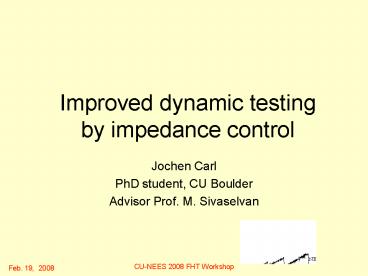Improved dynamic testing by impedance control - PowerPoint PPT Presentation
1 / 47
Title: Improved dynamic testing by impedance control
1
Improved dynamic testing by impedance control
- Jochen Carl
- PhD student, CU Boulder
- Advisor Prof. M. Sivaselvan
2
Controller-actuator
- Bad tracking
- inaccuracies
- instability
3
Effect of actuator-structure-interaction
Closed loop displacement control
step input
Closed loop displacement control
step input
4
Current compensation methods for bad actuator
tracking
Numerical damping of algorithm. Hilber, Hughes
and Taylor (1977) Error reduction
schemes. Combescure and Pegon (1997) Prediction
schemes. Nakashima and Masaoka (1999)
Methods do not account for actuator-structure-inte
raction. Risk of instability in particular for
high structure stiffness.
Switch between displacement and force control
A
C
Pan et al. (2004) Elkhoraibi and Mosalam
(2006) Dimig et al. (2001) Reinhorn et al. (2004)
5
Actuator-structure-interaction
Electromagnetic actuator
i
B
structure
Fs
i
Hydraulic actuator
structure
Fs
P1
P2
6
Electromagnetic actuator
F
structure/interaction force
-
x
actuator displacement
u
voltage input
7
Proportional feedback control
Voltage input in displacement control
u
output disp x
reference r
r-x
Interaction force for linear stiffness
The roots of the denominator polynomial are the
poles of the transfer function.
8
Root locus for increasing gain
9
Root locus for increasing gain
10
Root locus for increasing gain
11
Root locus for increasing gain
Increasing stiffness
12
Critical poles due to stiff structure
No damping and high risk of instability for stiff
structures.
13
Effect of structure stiffness
Problems of stiff structures Risk of instability
Problems of soft structures Dominant real pole
leads to slow system response.
Control requirements 1. Shift real pole into the
LHP and make complex poles dominant. 2.
Simultaneously avoid that the complex poles are
too close to the imaginary axis. Actuator
control must adjust to structure stiffness.
14
Impedance of coupled system
Fext
actuator
actuator
structure stiffness
structure stiffness
Structure stiffness
System impedance
Actuator impedance
15
Required actuator impedance
Fext
Required system impedance
Actuator impedance structure stiffness
16
Required actuator impedance
Fext
Required system impedance
Actuator impedance structure stiffness
17
Required actuator impedance
Fext
Required system impedance
Actuator impedance structure stiffness
18
Deformation due to structure
actuator
actuator
structure stiffness
structure stiffness
The actuator must allow the deformation xF in
response to the interaction force F.
19
Displacement error due to structure
Dynamic deformation
Static/DC deformation
20
Idea for compensation
F
F
-
-
r
21
My idea for error compensation
F
F
The additional input compensates for the static
actuator deformation.
-
-
ff
r
22
Disturbance rejection FF
Deformation due to interaction force using
feedforward compensation
statically
dynamically
23
Disturbance rejection comparison
24
Magnetorheological friction damper
Actuator gain designed for free motion. Coulomb
friction 9N
load cell
damper
25
Magnetorheological friction damper
Undisturbed actuator
Improved tracking by FF
Poor tracking due to disturbance
26
Magnetorheological friction damper
27
Root locus with FF and linear stiffness
Linear stiffness F kx
28
Root locus with FF and linear stiffness
Linear stiffness F kx
The FFx reduces the actuator impedance
automatically for increasing structure stiffness.
29
Electromagnetic actuator
30
Clamped brass bar modeling stiffness
31
Nonlinear stiffness
Plot shows approximation from stiffness
measurement.
32
FRF closed loop measured
33
Feedforwardimpedance
Actuator displacement
Desired
old
new
Infinitely stiff actuator
Flexible actuator
Instability
StabilityAccuracy
34
Actuator delay
Actuator delay is a typical problem in hybrid
testing as it adds energy into the system. This
is equivalent to negative damping, which is
approximated as
instability
Negative damping due to actuator delay
Shing and Mahin (1991)
A
C
35
Allowable gain range
Instability of hybrid loop
Actuator instability
36
Effect of negative damping
c
c
c
c
c
c
multisine ground acceleration
ü
g
g
m
m
m
k
k
k
k
nonlinear
x
Measured and simulated
For
37
Effect of negative damping
Compensation of actuator delay necessary, for
instance I-modification method. Combescure,
Pegon (1997)
Increased resonance peak due to actuator delay.
I-modification
perfect tracking
38
Stability limits for I-modification stiffness KI
c
c
c
c
c
c
multisine ground acceleration
ü
g
g
m
m
m
k
k
k
k
nonlinear
xx1
39
Stability limits for I-modification stiffness KI
max KI (instability due to overcompensation)
min KI (instability due to undercompensation)
Combescure and Pegon Stability for KI ks
40
FRF with multisine ground acceleration
- Test applies
- Nonlinear stiffness
- 3 damping of first mode
- FF I-modification
Test is stable and accurate.
41
FRF with multisine ground acceleration
Resonance 1
Resonance 2
Resonance 3
High signal-noise ratio
Anti-resonance
42
Tracking for El Centro earthquake
Phase lag could be compensated for but is still
present.
43
Tracking of higher frequencies
higher overshoot and settling time
Recommendation Keep gain constant as long as
structure stiffness is not known well.
lower phase lag
44
Recommended design in hybrid testing
45
Conclusion
F
FF designed to compensate for static deformation.
Actuator-structure-interaction affects actuator
tracking.
x
-
-
r
FF improves the actuator tracking and controls
the impedance of the actuator.
46
Acknowledgements
- PhD advisor Prof. Sivaselvan Mettupalayam
- Committee members Prof. Kaspar Willam, Prof.
Victor Saouma, Prof. Carlos Felippa, Dr.
Eric Stauffer, Dr. Gary Haussmann - Laboratory staff Robert Wallen, Thomas Bowen
- Financial support DAAD, University of Colorado
47
Thank you!
Questions?































